HSHM521 Financial Management in Healthcare: Melbourne Hospital Report
VerifiedAdded on 2023/06/03
|8
|1356
|265
Report
AI Summary
This report provides a comprehensive financial analysis of Melbourne Hospital, including the creation of a balance sheet, profit and loss statement, and cash flow statement for the year 2017. It analyzes the hospital's major debts and liquid assets, highlighting a potential lack of liquidity. The report also examines the cash flows from operating, investing, and financing activities, noting a negative cash flow from operations and a loss reported in the profit and loss statement, with a discussion on the differences arising from accrual versus cash basis accounting. Furthermore, the report includes a cash flow and profit and loss statement for Bendigo General Practice, discussing the differences in balances and key factors to consider when purchasing the business, such as profitability, cash flows, and financial ratios. Desklib offers a wealth of similar solved assignments and study resources for students.
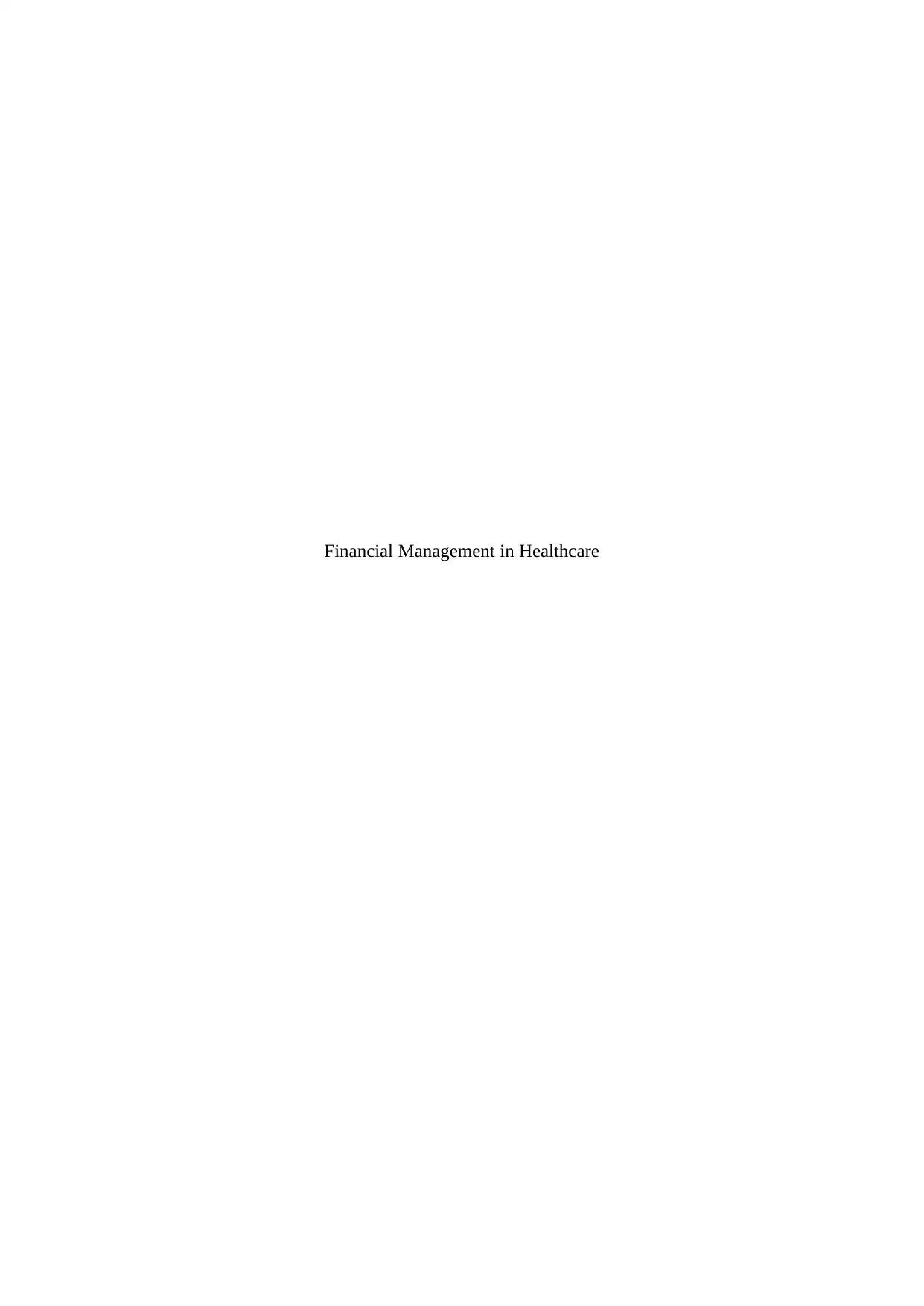
Financial Management in Healthcare
Paraphrase This Document
Need a fresh take? Get an instant paraphrase of this document with our AI Paraphraser
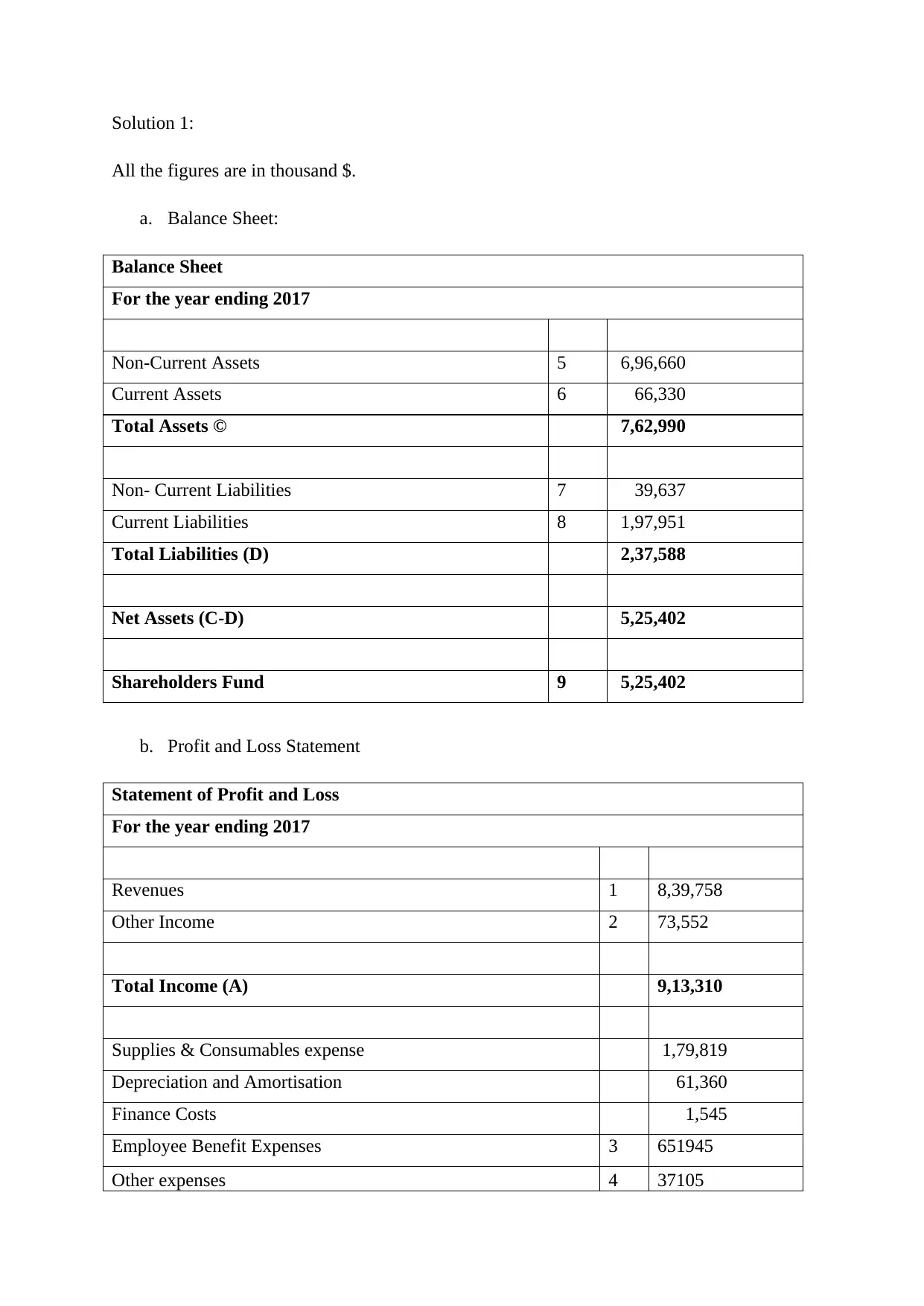
Solution 1:
All the figures are in thousand $.
a. Balance Sheet:
Balance Sheet
For the year ending 2017
Non-Current Assets 5 6,96,660
Current Assets 6 66,330
Total Assets © 7,62,990
Non- Current Liabilities 7 39,637
Current Liabilities 8 1,97,951
Total Liabilities (D) 2,37,588
Net Assets (C-D) 5,25,402
Shareholders Fund 9 5,25,402
b. Profit and Loss Statement
Statement of Profit and Loss
For the year ending 2017
Revenues 1 8,39,758
Other Income 2 73,552
Total Income (A) 9,13,310
Supplies & Consumables expense 1,79,819
Depreciation and Amortisation 61,360
Finance Costs 1,545
Employee Benefit Expenses 3 651945
Other expenses 4 37105
All the figures are in thousand $.
a. Balance Sheet:
Balance Sheet
For the year ending 2017
Non-Current Assets 5 6,96,660
Current Assets 6 66,330
Total Assets © 7,62,990
Non- Current Liabilities 7 39,637
Current Liabilities 8 1,97,951
Total Liabilities (D) 2,37,588
Net Assets (C-D) 5,25,402
Shareholders Fund 9 5,25,402
b. Profit and Loss Statement
Statement of Profit and Loss
For the year ending 2017
Revenues 1 8,39,758
Other Income 2 73,552
Total Income (A) 9,13,310
Supplies & Consumables expense 1,79,819
Depreciation and Amortisation 61,360
Finance Costs 1,545
Employee Benefit Expenses 3 651945
Other expenses 4 37105
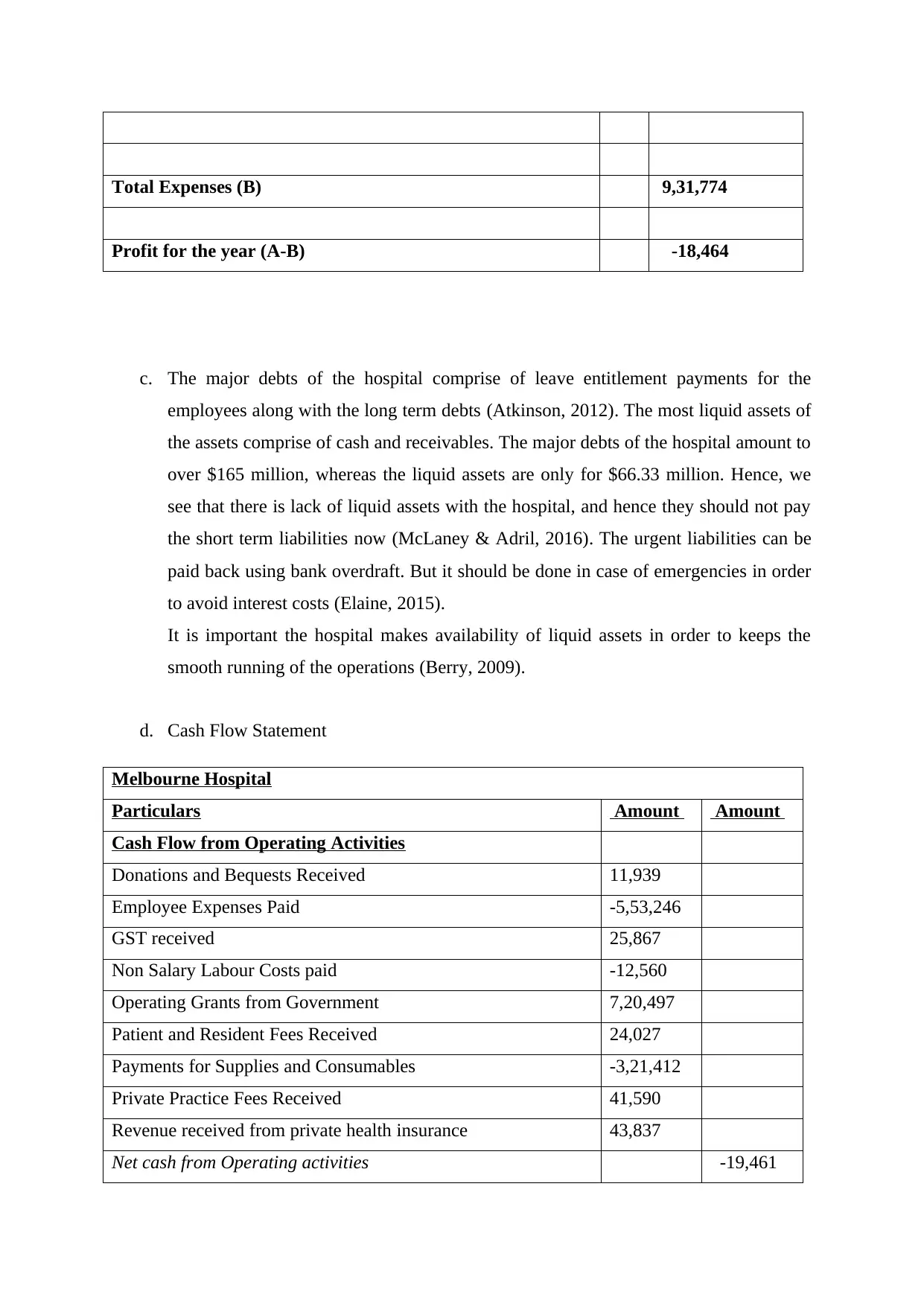
Total Expenses (B) 9,31,774
Profit for the year (A-B) -18,464
c. The major debts of the hospital comprise of leave entitlement payments for the
employees along with the long term debts (Atkinson, 2012). The most liquid assets of
the assets comprise of cash and receivables. The major debts of the hospital amount to
over $165 million, whereas the liquid assets are only for $66.33 million. Hence, we
see that there is lack of liquid assets with the hospital, and hence they should not pay
the short term liabilities now (McLaney & Adril, 2016). The urgent liabilities can be
paid back using bank overdraft. But it should be done in case of emergencies in order
to avoid interest costs (Elaine, 2015).
It is important the hospital makes availability of liquid assets in order to keeps the
smooth running of the operations (Berry, 2009).
d. Cash Flow Statement
Melbourne Hospital
Particulars Amount Amount
Cash Flow from Operating Activities
Donations and Bequests Received 11,939
Employee Expenses Paid -5,53,246
GST received 25,867
Non Salary Labour Costs paid -12,560
Operating Grants from Government 7,20,497
Patient and Resident Fees Received 24,027
Payments for Supplies and Consumables -3,21,412
Private Practice Fees Received 41,590
Revenue received from private health insurance 43,837
Net cash from Operating activities -19,461
Profit for the year (A-B) -18,464
c. The major debts of the hospital comprise of leave entitlement payments for the
employees along with the long term debts (Atkinson, 2012). The most liquid assets of
the assets comprise of cash and receivables. The major debts of the hospital amount to
over $165 million, whereas the liquid assets are only for $66.33 million. Hence, we
see that there is lack of liquid assets with the hospital, and hence they should not pay
the short term liabilities now (McLaney & Adril, 2016). The urgent liabilities can be
paid back using bank overdraft. But it should be done in case of emergencies in order
to avoid interest costs (Elaine, 2015).
It is important the hospital makes availability of liquid assets in order to keeps the
smooth running of the operations (Berry, 2009).
d. Cash Flow Statement
Melbourne Hospital
Particulars Amount Amount
Cash Flow from Operating Activities
Donations and Bequests Received 11,939
Employee Expenses Paid -5,53,246
GST received 25,867
Non Salary Labour Costs paid -12,560
Operating Grants from Government 7,20,497
Patient and Resident Fees Received 24,027
Payments for Supplies and Consumables -3,21,412
Private Practice Fees Received 41,590
Revenue received from private health insurance 43,837
Net cash from Operating activities -19,461
⊘ This is a preview!⊘
Do you want full access?
Subscribe today to unlock all pages.

Trusted by 1+ million students worldwide
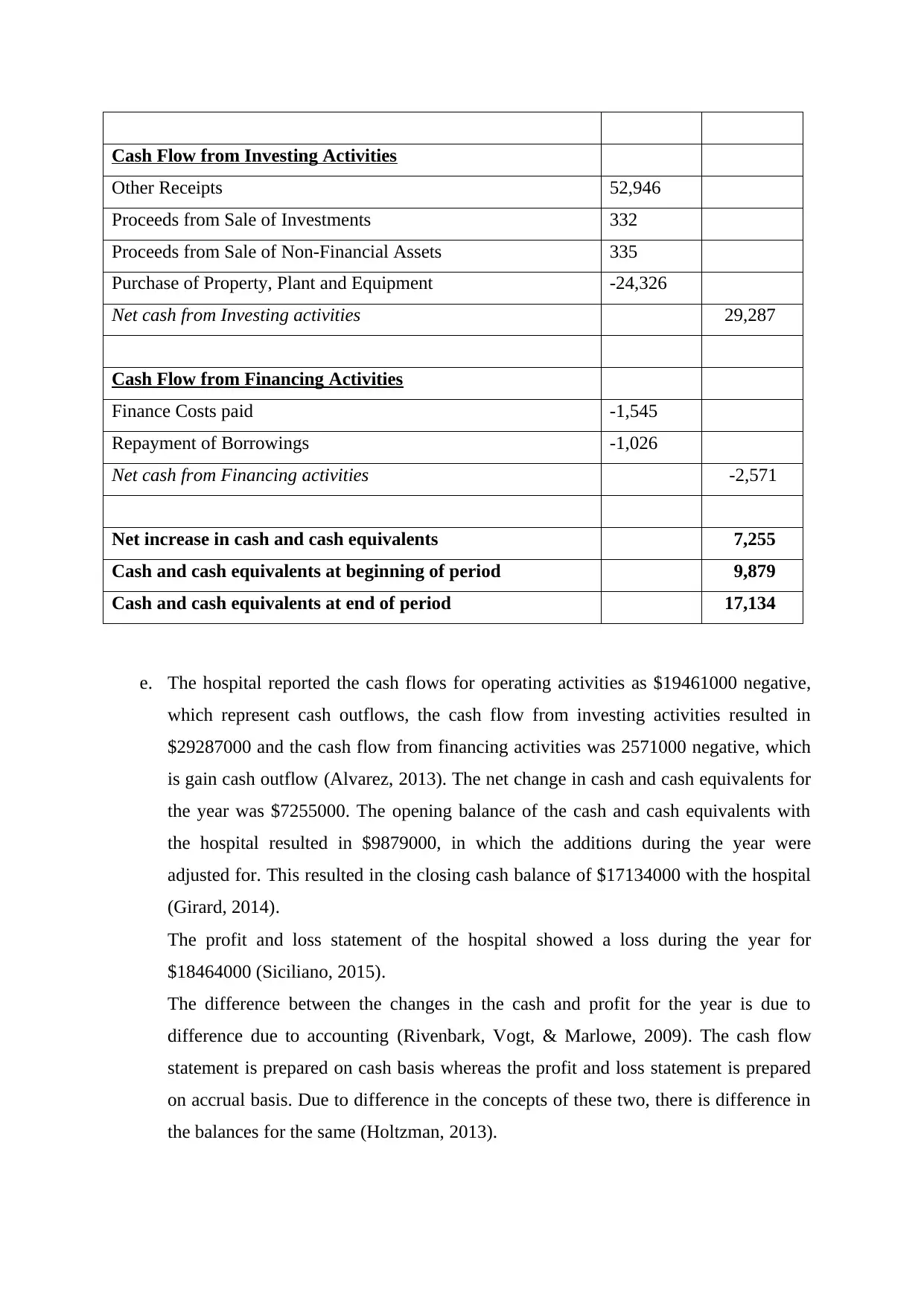
Cash Flow from Investing Activities
Other Receipts 52,946
Proceeds from Sale of Investments 332
Proceeds from Sale of Non-Financial Assets 335
Purchase of Property, Plant and Equipment -24,326
Net cash from Investing activities 29,287
Cash Flow from Financing Activities
Finance Costs paid -1,545
Repayment of Borrowings -1,026
Net cash from Financing activities -2,571
Net increase in cash and cash equivalents 7,255
Cash and cash equivalents at beginning of period 9,879
Cash and cash equivalents at end of period 17,134
e. The hospital reported the cash flows for operating activities as $19461000 negative,
which represent cash outflows, the cash flow from investing activities resulted in
$29287000 and the cash flow from financing activities was 2571000 negative, which
is gain cash outflow (Alvarez, 2013). The net change in cash and cash equivalents for
the year was $7255000. The opening balance of the cash and cash equivalents with
the hospital resulted in $9879000, in which the additions during the year were
adjusted for. This resulted in the closing cash balance of $17134000 with the hospital
(Girard, 2014).
The profit and loss statement of the hospital showed a loss during the year for
$18464000 (Siciliano, 2015).
The difference between the changes in the cash and profit for the year is due to
difference due to accounting (Rivenbark, Vogt, & Marlowe, 2009). The cash flow
statement is prepared on cash basis whereas the profit and loss statement is prepared
on accrual basis. Due to difference in the concepts of these two, there is difference in
the balances for the same (Holtzman, 2013).
Other Receipts 52,946
Proceeds from Sale of Investments 332
Proceeds from Sale of Non-Financial Assets 335
Purchase of Property, Plant and Equipment -24,326
Net cash from Investing activities 29,287
Cash Flow from Financing Activities
Finance Costs paid -1,545
Repayment of Borrowings -1,026
Net cash from Financing activities -2,571
Net increase in cash and cash equivalents 7,255
Cash and cash equivalents at beginning of period 9,879
Cash and cash equivalents at end of period 17,134
e. The hospital reported the cash flows for operating activities as $19461000 negative,
which represent cash outflows, the cash flow from investing activities resulted in
$29287000 and the cash flow from financing activities was 2571000 negative, which
is gain cash outflow (Alvarez, 2013). The net change in cash and cash equivalents for
the year was $7255000. The opening balance of the cash and cash equivalents with
the hospital resulted in $9879000, in which the additions during the year were
adjusted for. This resulted in the closing cash balance of $17134000 with the hospital
(Girard, 2014).
The profit and loss statement of the hospital showed a loss during the year for
$18464000 (Siciliano, 2015).
The difference between the changes in the cash and profit for the year is due to
difference due to accounting (Rivenbark, Vogt, & Marlowe, 2009). The cash flow
statement is prepared on cash basis whereas the profit and loss statement is prepared
on accrual basis. Due to difference in the concepts of these two, there is difference in
the balances for the same (Holtzman, 2013).
Paraphrase This Document
Need a fresh take? Get an instant paraphrase of this document with our AI Paraphraser
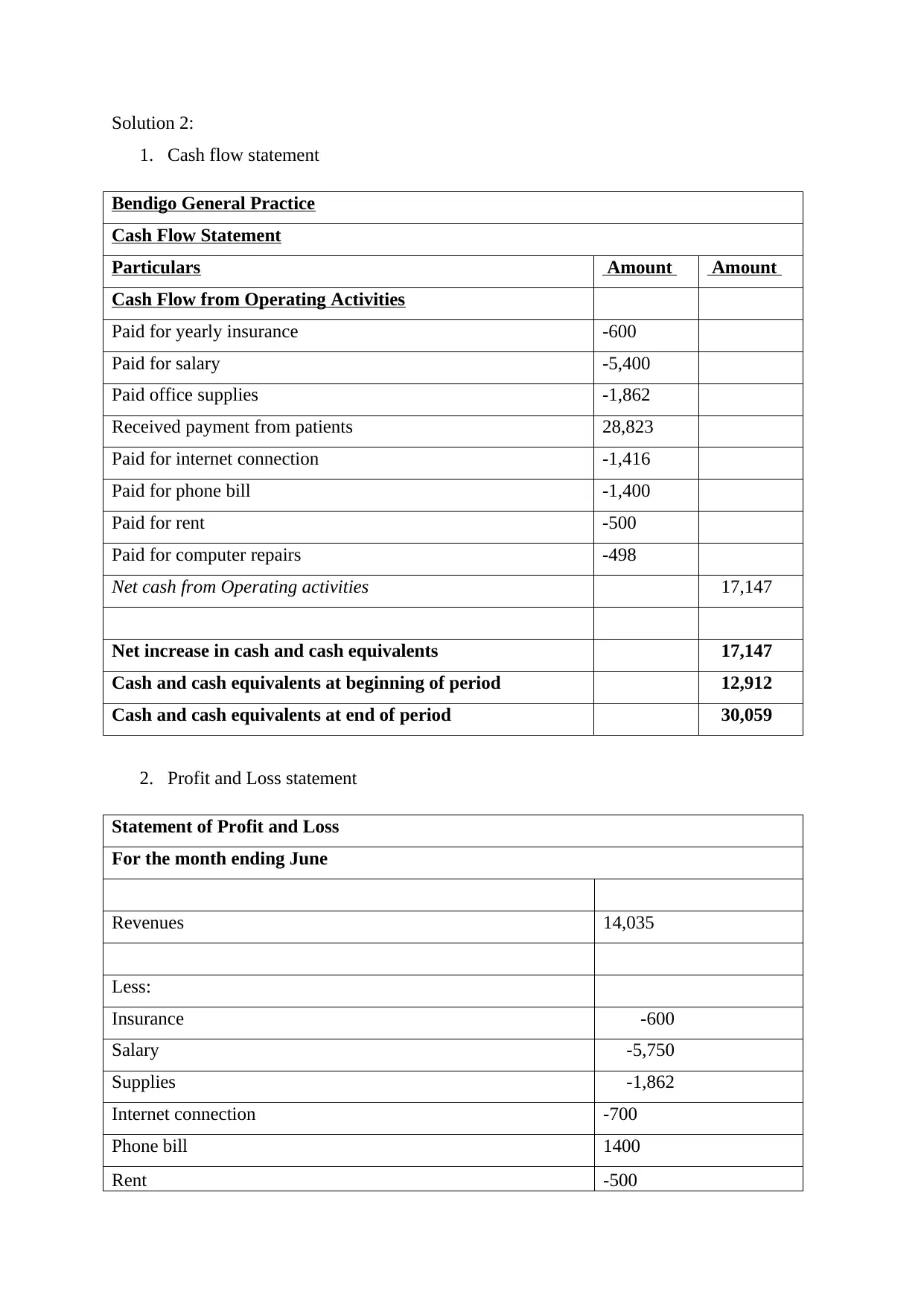
Solution 2:
1. Cash flow statement
Bendigo General Practice
Cash Flow Statement
Particulars Amount Amount
Cash Flow from Operating Activities
Paid for yearly insurance -600
Paid for salary -5,400
Paid office supplies -1,862
Received payment from patients 28,823
Paid for internet connection -1,416
Paid for phone bill -1,400
Paid for rent -500
Paid for computer repairs -498
Net cash from Operating activities 17,147
Net increase in cash and cash equivalents 17,147
Cash and cash equivalents at beginning of period 12,912
Cash and cash equivalents at end of period 30,059
2. Profit and Loss statement
Statement of Profit and Loss
For the month ending June
Revenues 14,035
Less:
Insurance -600
Salary -5,750
Supplies -1,862
Internet connection -700
Phone bill 1400
Rent -500
1. Cash flow statement
Bendigo General Practice
Cash Flow Statement
Particulars Amount Amount
Cash Flow from Operating Activities
Paid for yearly insurance -600
Paid for salary -5,400
Paid office supplies -1,862
Received payment from patients 28,823
Paid for internet connection -1,416
Paid for phone bill -1,400
Paid for rent -500
Paid for computer repairs -498
Net cash from Operating activities 17,147
Net increase in cash and cash equivalents 17,147
Cash and cash equivalents at beginning of period 12,912
Cash and cash equivalents at end of period 30,059
2. Profit and Loss statement
Statement of Profit and Loss
For the month ending June
Revenues 14,035
Less:
Insurance -600
Salary -5,750
Supplies -1,862
Internet connection -700
Phone bill 1400
Rent -500
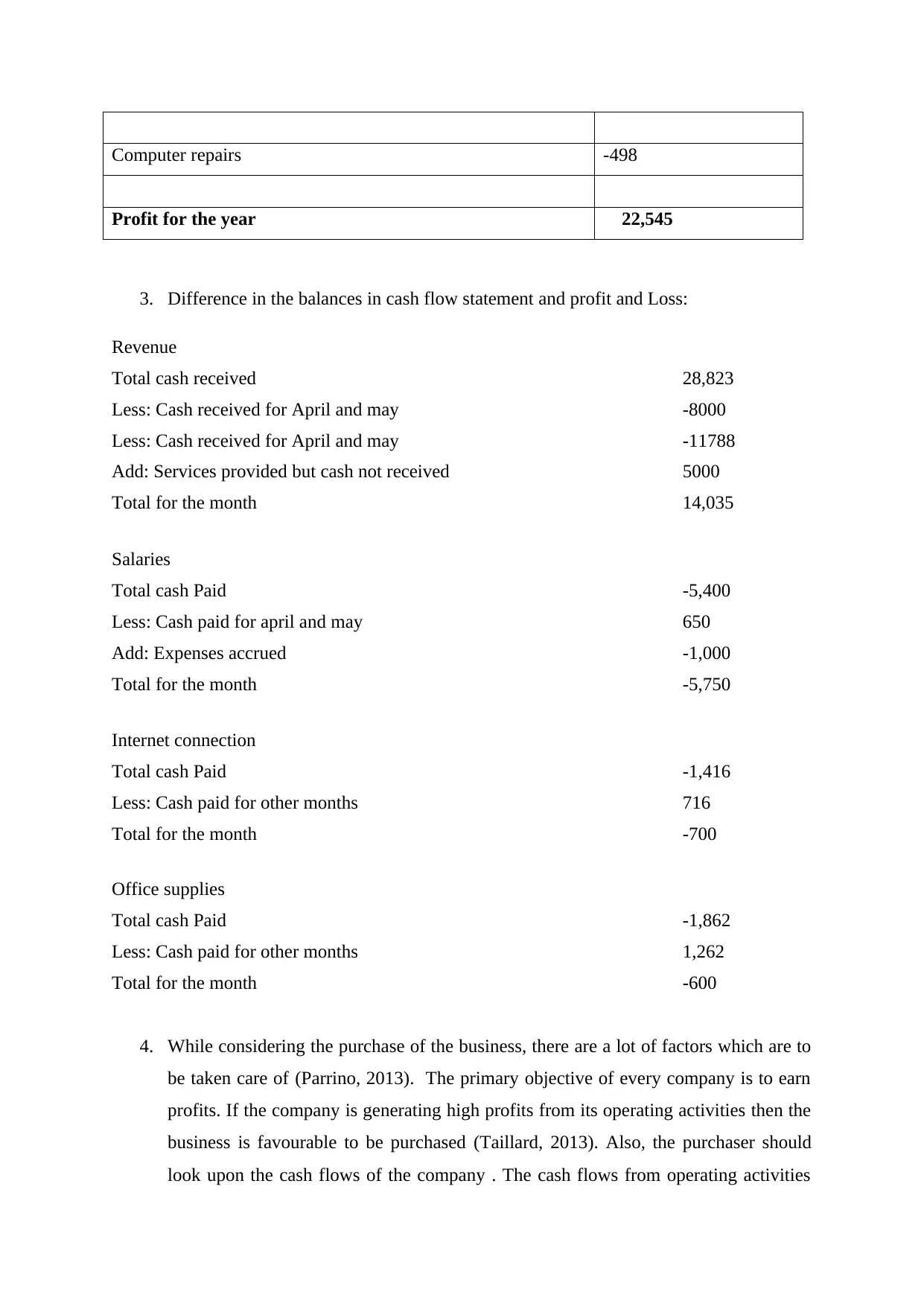
Computer repairs -498
Profit for the year 22,545
3. Difference in the balances in cash flow statement and profit and Loss:
Revenue
Total cash received 28,823
Less: Cash received for April and may -8000
Less: Cash received for April and may -11788
Add: Services provided but cash not received 5000
Total for the month 14,035
Salaries
Total cash Paid -5,400
Less: Cash paid for april and may 650
Add: Expenses accrued -1,000
Total for the month -5,750
Internet connection
Total cash Paid -1,416
Less: Cash paid for other months 716
Total for the month -700
Office supplies
Total cash Paid -1,862
Less: Cash paid for other months 1,262
Total for the month -600
4. While considering the purchase of the business, there are a lot of factors which are to
be taken care of (Parrino, 2013). The primary objective of every company is to earn
profits. If the company is generating high profits from its operating activities then the
business is favourable to be purchased (Taillard, 2013). Also, the purchaser should
look upon the cash flows of the company . The cash flows from operating activities
Profit for the year 22,545
3. Difference in the balances in cash flow statement and profit and Loss:
Revenue
Total cash received 28,823
Less: Cash received for April and may -8000
Less: Cash received for April and may -11788
Add: Services provided but cash not received 5000
Total for the month 14,035
Salaries
Total cash Paid -5,400
Less: Cash paid for april and may 650
Add: Expenses accrued -1,000
Total for the month -5,750
Internet connection
Total cash Paid -1,416
Less: Cash paid for other months 716
Total for the month -700
Office supplies
Total cash Paid -1,862
Less: Cash paid for other months 1,262
Total for the month -600
4. While considering the purchase of the business, there are a lot of factors which are to
be taken care of (Parrino, 2013). The primary objective of every company is to earn
profits. If the company is generating high profits from its operating activities then the
business is favourable to be purchased (Taillard, 2013). Also, the purchaser should
look upon the cash flows of the company . The cash flows from operating activities
⊘ This is a preview!⊘
Do you want full access?
Subscribe today to unlock all pages.

Trusted by 1+ million students worldwide
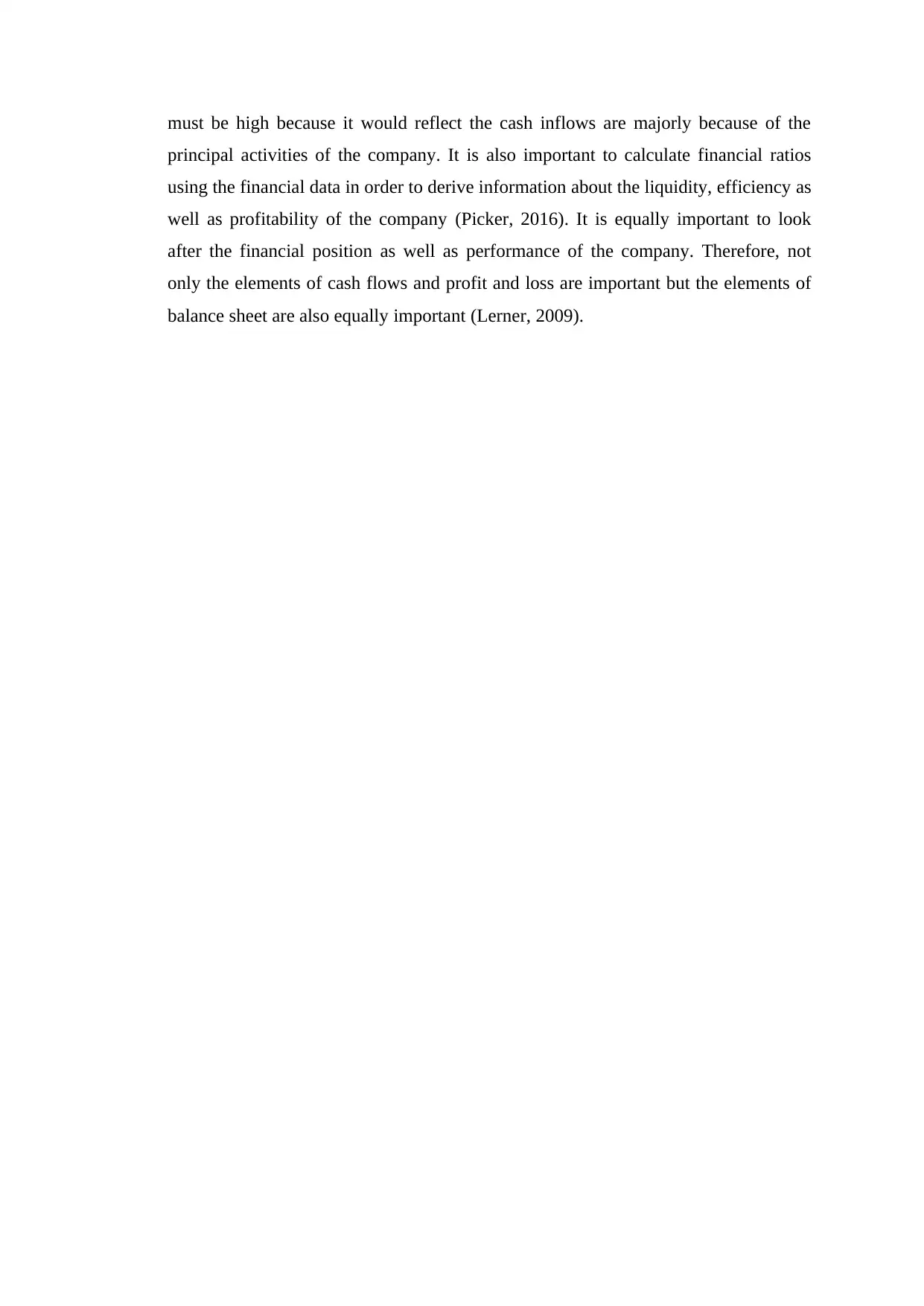
must be high because it would reflect the cash inflows are majorly because of the
principal activities of the company. It is also important to calculate financial ratios
using the financial data in order to derive information about the liquidity, efficiency as
well as profitability of the company (Picker, 2016). It is equally important to look
after the financial position as well as performance of the company. Therefore, not
only the elements of cash flows and profit and loss are important but the elements of
balance sheet are also equally important (Lerner, 2009).
principal activities of the company. It is also important to calculate financial ratios
using the financial data in order to derive information about the liquidity, efficiency as
well as profitability of the company (Picker, 2016). It is equally important to look
after the financial position as well as performance of the company. Therefore, not
only the elements of cash flows and profit and loss are important but the elements of
balance sheet are also equally important (Lerner, 2009).
Paraphrase This Document
Need a fresh take? Get an instant paraphrase of this document with our AI Paraphraser
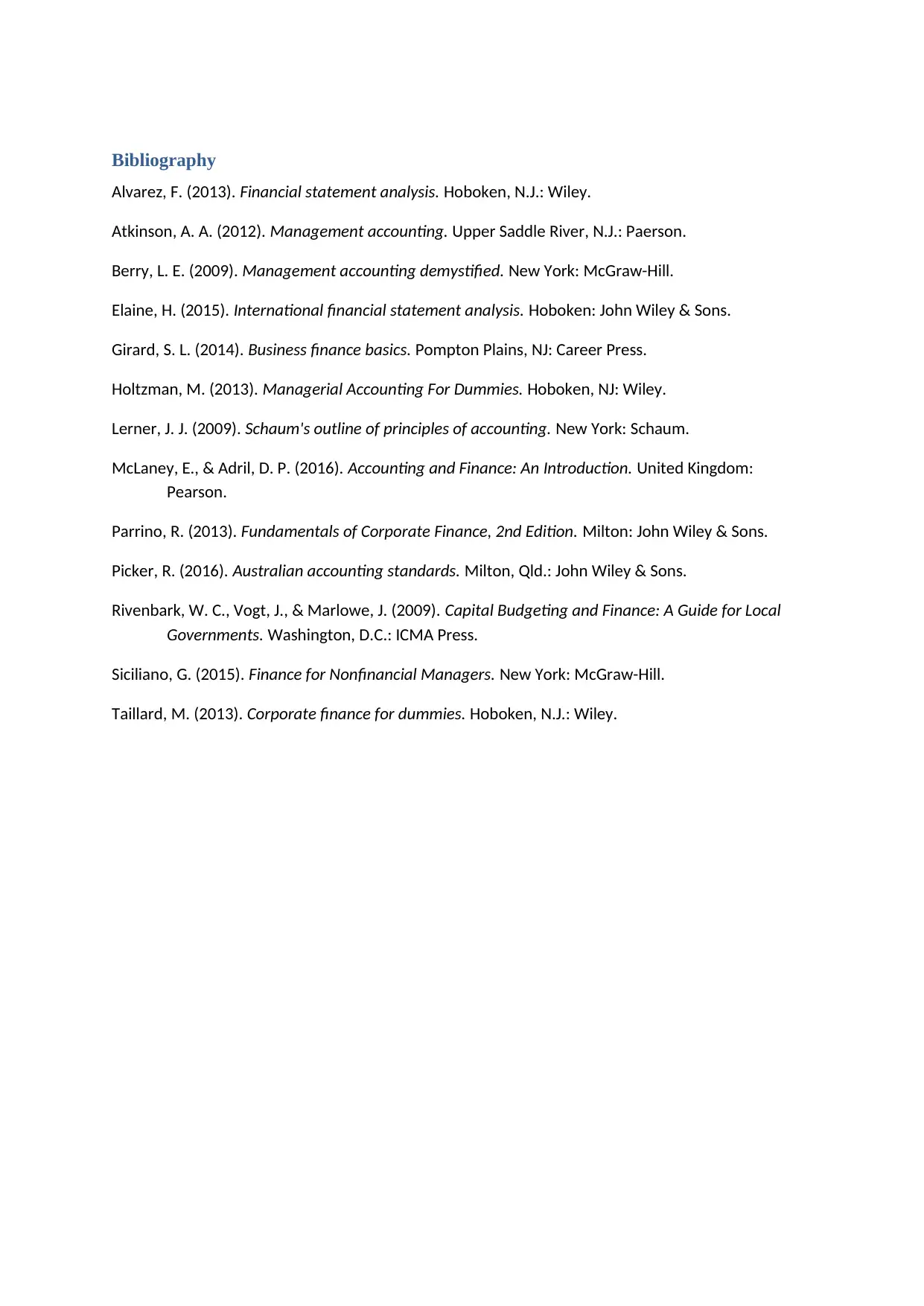
Bibliography
Alvarez, F. (2013). Financial statement analysis. Hoboken, N.J.: Wiley.
Atkinson, A. A. (2012). Management accounting. Upper Saddle River, N.J.: Paerson.
Berry, L. E. (2009). Management accounting demystified. New York: McGraw-Hill.
Elaine, H. (2015). International financial statement analysis. Hoboken: John Wiley & Sons.
Girard, S. L. (2014). Business finance basics. Pompton Plains, NJ: Career Press.
Holtzman, M. (2013). Managerial Accounting For Dummies. Hoboken, NJ: Wiley.
Lerner, J. J. (2009). Schaum's outline of principles of accounting. New York: Schaum.
McLaney, E., & Adril, D. P. (2016). Accounting and Finance: An Introduction. United Kingdom:
Pearson.
Parrino, R. (2013). Fundamentals of Corporate Finance, 2nd Edition. Milton: John Wiley & Sons.
Picker, R. (2016). Australian accounting standards. Milton, Qld.: John Wiley & Sons.
Rivenbark, W. C., Vogt, J., & Marlowe, J. (2009). Capital Budgeting and Finance: A Guide for Local
Governments. Washington, D.C.: ICMA Press.
Siciliano, G. (2015). Finance for Nonfinancial Managers. New York: McGraw-Hill.
Taillard, M. (2013). Corporate finance for dummies. Hoboken, N.J.: Wiley.
Alvarez, F. (2013). Financial statement analysis. Hoboken, N.J.: Wiley.
Atkinson, A. A. (2012). Management accounting. Upper Saddle River, N.J.: Paerson.
Berry, L. E. (2009). Management accounting demystified. New York: McGraw-Hill.
Elaine, H. (2015). International financial statement analysis. Hoboken: John Wiley & Sons.
Girard, S. L. (2014). Business finance basics. Pompton Plains, NJ: Career Press.
Holtzman, M. (2013). Managerial Accounting For Dummies. Hoboken, NJ: Wiley.
Lerner, J. J. (2009). Schaum's outline of principles of accounting. New York: Schaum.
McLaney, E., & Adril, D. P. (2016). Accounting and Finance: An Introduction. United Kingdom:
Pearson.
Parrino, R. (2013). Fundamentals of Corporate Finance, 2nd Edition. Milton: John Wiley & Sons.
Picker, R. (2016). Australian accounting standards. Milton, Qld.: John Wiley & Sons.
Rivenbark, W. C., Vogt, J., & Marlowe, J. (2009). Capital Budgeting and Finance: A Guide for Local
Governments. Washington, D.C.: ICMA Press.
Siciliano, G. (2015). Finance for Nonfinancial Managers. New York: McGraw-Hill.
Taillard, M. (2013). Corporate finance for dummies. Hoboken, N.J.: Wiley.
1 out of 8
Related Documents
Your All-in-One AI-Powered Toolkit for Academic Success.
+13062052269
info@desklib.com
Available 24*7 on WhatsApp / Email
![[object Object]](/_next/static/media/star-bottom.7253800d.svg)
Unlock your academic potential
Copyright © 2020–2025 A2Z Services. All Rights Reserved. Developed and managed by ZUCOL.




